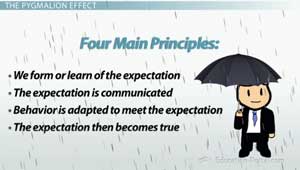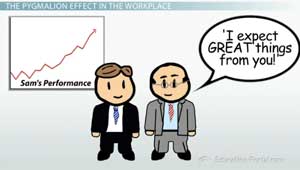The Pygmalion Effect: Influencing Employee Behavior - Quiz
Choose your answer and write the correct one down. Then click HERE for the answers to this quiz.
NOTE: The transcript from the video is listed below the quiz for your reference.
1. Which of these terms describes the idea that most people will adapt their behavior to meet an expectation?
- the python effect
- the Pygmalion effect
- the fulfillment effect
- the great expectations effect
- the self-serving effect
2. Which of these terms is considered synonymous with the Pygmalion effect?
- the self-fulfillment prophecy
- the self-fulfilling prophecy
- the self-serving effect
- the python effect
- the great expectations prophecy
3. Which of these are not considered one of the four principles of the Pygmalion Effect?
- we form or learn of the expectation
- the expectation is communicated
- behavior is adapted to meet the expectation
- the expectation then becomes true
- we assess the behavior against the expectation
4. Which of these is the most common way a manager can form an expectation and communicate it to an employee?
- performance reviews
- modeling behavior
- 360 degree feedback
- mentoring
- new employee orientation
5. What is the typical response to behaviors that receive a positive ranking on a performance review?
- they will likely be repeated
- they will be discontinued
- they will be become the minimal acceptable level of behavior
- they will become the maximum acceptable level of behavior
- none of these responses
Setting expectations for employee performance and behavior is one of the primary responsibilities of management. This lesson defines the Pygmalion Effect and describes how it is used to influence employee behavior.
The Power of Expectations
It's 5:00 AM, and Sam's alarm clock begins to ring. When he reaches to hit snooze so that he can have five more precious minutes of sleep, he accidently knocks it off of the table. He has to scramble to find it in the dark. Unfortunately, in the process, he also bangs his head on the nightstand. Sam says to himself, 'This is going to be a horrible day.'
As Sam goes about his day, it seems like everything goes wrong for him. Because he was so focused on the alarm clock falling onto the floor and not on his driving, he ends up rear-ending another car on his way into work. After exchanging insurance information with the other driver, Sam finishes his commute to the office. Once there, he is in a bad mood, so he is impatient with his coworkers. They, in turn, are rude right back. Sam thinks to himself, 'See, I knew this was going to be a bad day. Why did I even get out of bed?'
Now, Sam is not a physic who can read the future, so why did his predictions of having a bad day come true? The answer can be found in the expectation that he set for himself the moment that he said, 'Today is going to be a horrible day.'
The Pygmalion Effect
The idea that most people will adapt their behavior to meet an expectation is known as the Pygmalion Effect. A more common term used to describe this phenomenon is called the self-fulfilling prophecy.
 |
 |
So, while your expectation of rain did come true, it did not come true because you expected it to. Again, the expectation itself has to cause some change in behavior to make the expectation come true.
 |
- We form or learn of the expectation
- The expectation is communicated
- Behavior is adapted to meet the expectation
- The expectation then becomes true
The Pygmalion Effect in the Workplace
Meeting the expectations that others set for us is something that we do from early on in our lives. In school, we work hard to learn new concepts and perform well on tests to meet the expectations of our parents and teachers. In sports, we push ourselves physically to meet the expectations of our coaches, teammates and fans. In relationships, we adapt our behavior to meet the expectations of our partner. Likewise, in the workplace, an employee will adapt his or her behavior and level of performance to meet the expectations set by their manager and the organization.
The expectations that a manager holds of his or her employees can powerfully influence the employees' behavior. Managers must understand this influence and how to harness it to work towards organizational goals. The most common way a manager can form an expectation and communicate it to an employee is through performance reviews. The performance review serves as an appraisal of an employee's past performance, the level of raise that he or she will be awarded and areas of improvement. What many managers fail to realize is that the performance appraisal is also a powerful tool that can be used to influence future performance.
Influencing Workplace Behavior
To better see how the Pygmalion Effect is used to influence workplace behavior through performance reviews, let's look at the following example.
 |
When filling out Marcus's performance review, his manager must take all of these behaviors into consideration. His strengths would mandate his manager to give him an 'excellent' or 'above average' rating whereas his weaknesses would be placed in the 'poor' or 'below average' category. When it is all said and done, Marcus' overall score would be 'average.' However, Marcus' manager has the expectation that Marcus will be an above average employee and communicates that expectation to him during this review.
By ranking Marcus' behavior as positive and negative, his manager (whether he knows it or not) is shaping Marcus' future behavior and performance at Furniture Mania. In the areas where Marcus' behaviors were marked as 'excellent' or 'above average,' Marcus will continue to behave in that manner. This is in contrast to the areas where Marcus's behaviors were marked as 'poor' or 'below average.' According to the Pygmalion Effect, Marcus will now refrain from those behaviors that resulted in the negative assessment so that he can work towards meeting his manager's expectation for him to earn an above average rating in the next performance review. Again, this is because performance rankings do not just summarize past performance, but also help shape future performance as well though the power of expectations.
 |
Lesson Summary
Let's review. The Pygmalion Effect, also known as the self-fulfilling prophecy, describes a phenomenon of how an expectation can be used to shape a person's behavior to act in accordance with the expectation. There are four main principles to the Pygmalion Effect:
- We form or learn of the expectation
- The expectation is communicated
- Behavior is adapted to meet the expectation
- The expectation then becomes true
However, it does not make the expectation come full circle when you just have an expectation and then it happens. Instead, the expectation has to be the cause or reason why something occurs.
In the workplace, an employee will adapt his or her behavior and level of performance to meet the expectations set by their manager and the organization. The most common way a manager can form an expectation and communicate it to an employee is through performance reviews. Performance reviews do not just summarize past performance; they also help shape future performance though the power of expectations. When the expectation is set by a manager for an employee to earn an above average performance review, the employee must be shown how his or her positive behaviors need to outweigh his or her negative ones. Performance behaviors that receive a favorable ranking will likely be repeated, and those that earn a poor ranking will likely be discontinued.